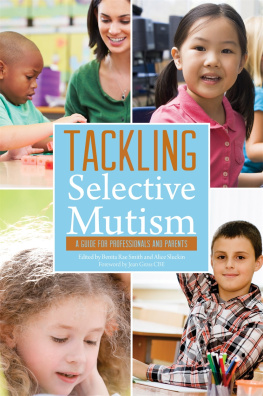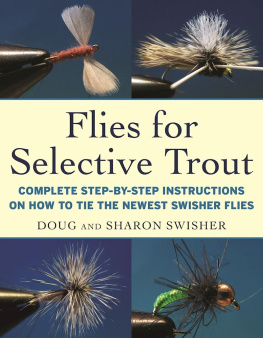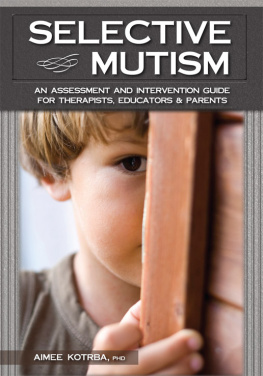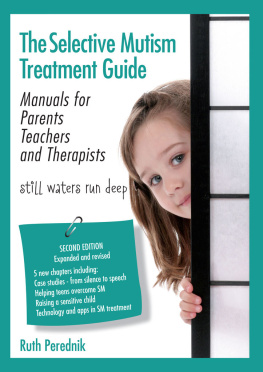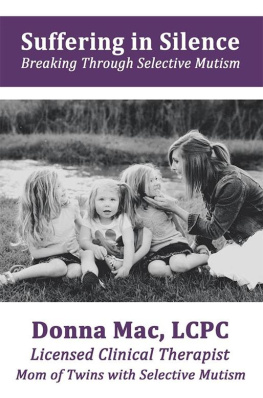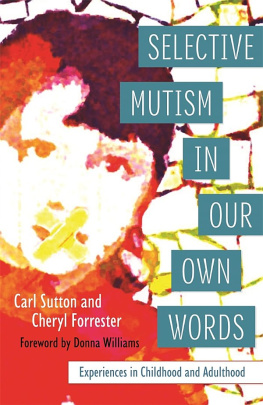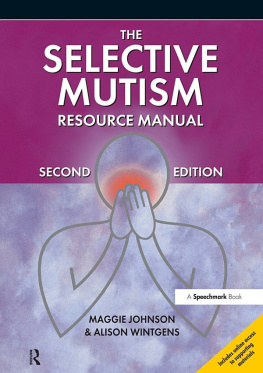Acknowledgements
We are extremely grateful to the following people:
The children and families who made it possible for this book to be even considered
Dr Agnes Hauck for valuable professional guidance over a long period
Alison Huneke of the Association for All Speech Impaired Children (Afasic) for helpline advice
Annie Elias, Jane Shaw, Hilary Cleator and Professor Paul Carding for advice on functional voice disorders
Helen Webb and Denise Lanes for collaboration in the preparation of
Victoria Roe for meticulous fact-checking in
Kumi Andoh for services above and beyond mere translation from the Japanese
Lucy Buckroyd and Kate Mason, our editors at Jessica Kingsley Publishers, for unfailing support and encouragement
Our own families for tolerance, endless support, helpful comment and proofreading.
Royalties from this book will be donated to SMIRA (Selective Mutism Information & Research Association) and Afasic (Association for all Speech Impaired Children).
APPENDIX
Selective Mutism in Adults
Carl Sutton
iSpeak is a non-profit organization which I formed in early 2012: (a) to address the lack of professional understanding and support for older teenagers and adults with Selective Mutism (SM); (b) to counter the popular perception that SM is just a childhood disorder; and (c) to provide a sufferer-led view of SM. We provide primarily online support for older teenagers and adults with SM, support to parents, advice to practitioners, and conduct academic research on SM.
Throughout 2013, during a Psychology conversion MSc at the University of Chester (UK), I conducted the first study of SM in adults. The study was advertised online on the iSpeak website, the SMG~CAN website, and through word-of-mouth by SMIRA.
It was demonstrated that a significant number of adults continue to experience SM; that is to say they speak freely in some situations but feel themselves consistently unable to talk in others. Eighty-three adults from 11 countries took part in the study, responding online or via paper questionnaires, the majority coming from the UK and USA. All participants indicated that they experienced SM beyond age 18. Seventy-nine adults said they were still suffering with SM at the time of taking part in the study. The age range of participants was between 18 and 64, with a mean age of 33.4. In agreement with all other studies on SM, which indicate that the onset of the disorder is generally between two and four years of age, the mean age of onset for adults with SM in this sample was 3.78.
There was a much higher gender ratio than in any other study on SM of approximately four females to one male. Some of this bias may be due to adult males being more likely to self-stigmatize and thus being less likely to take part in this kind of research; however, it does cast some doubt on the 1:1 gender ratio indicated in DSM-5 (APA 2013), particularly when one considers that all other anxiety disorders (which DSM-5 now categorizes SM as) have a female preponderance of between 2:1 and 3:1.
Interestingly, seven of the adults with SM who took part (all mothers) had children with SM indicating a genetic, predisposing and/or social-learning aspect to SM. Additionally, the majority of respondents suggested that the trigger for their SM had been minor or there had been no memorable trigger at all. However, 22 per cent indicated that abuse in the childhood home (emotional, physical and/or vicarious e.g. witnessing domestic violence) had triggered or compounded their SM; and 40 per cent indicated that bullying at school had triggered or compounded their SM. SM is thus likely to be a gene plus environment interaction, occurring for multifarious reasons, including no reason, and including (infrequently) stressors at home.
The study addressed a number of key questions relating to the long-term course of the disorder and adult co-morbidities for the estimated 23 per cent of children with SM whose SM continues into adulthood.
First of all the study clearly demonstrated that SM in adults exists; a simple finding which needs to be stated because the majority of academic research is on children with SM and further that SM in adults is uncommon, but not rare. While mean peak severity of the disorder appears to occur between ages 12 and 19, severity generally decreasing thereafter until around age 60, some adults (particularly those who reported significant stressors in childhood) continue to experience SM into their 50s.
Many adults with SM lead fulfilled lives, have life partners, and, in many cases, work. This is not to say it is easy, however, as many express the difficulties they have progressing at work. Among adults with a degree of SM there are teachers, lecturers, artists, people in caring and medical professions and (in my own case) a software engineer. On the other hand, there are also many adults with SM who can barely leave the house alone, experiencing agoraphobia in addition to SM and are thus unable to seek employment interviews being the first major hurdle. This would suggest that access to benefits may also be a problem for them.
Second, the research also showed that only around 25 per cent of adults with SM received diagnoses of SM in childhood; a further 25 per cent of adults with SM indicated that, as children, their parents were unaware of their SM; and a further 25 per cent of adults with SM had parents who were aware of their childs difference but did not know SM was a known condition per se and did not seek help for their children.
Things appear to be improving in this regard, however. Younger participants were more likely to have received a diagnosis, which may indicate that diagnosis rates have increased, particularly post-1994 (after publication of DSM-IV , the beginning of the influence of organizations such as SMIRA, and at the beginning of the rapid growth of the internet).
Interestingly, the diagnosis rates in the UK and USA appear to be roughly the same. However, it should also be noted that diagnosis in childhood does not predict recovery by adulthood, according to this study. A diagnosis in itself is worthless without appropriate and effective therapeutic intervention. Those taking part in this study who received diagnoses as children became adults with SM, even if they received treatment as children. In fact, many adults with SM cited the intervention they received as unhelpful or detrimental, though the types of treatment offered are unfortunately not known. At this juncture, professional awareness of SM in adults appears to be poor/non-existent and there is nowhere for adults with SM to turn.
Third, according to this research, adults with SM are very significantly more likely than the general population to develop other mood- and anxiety-related conditions, most notably depression, anxiety, panic disorder, social anxiety and PTSD. For some, chronic mental health conditions are a factor in their lives. Most indicated that they felt their long-term mental health conditions could have been avoided with appropriate support at the appropriate time in childhood. Adults with SM indicated what could have helped most was: (a) better understanding of SM in the school system; (b) access to counselling or CBT in childhood; and/or (c) access to speech therapy services. Of professionals, with exceptions (some teachers having been helpful), teachers were noted to be both the least likely to help with SM and most likely to make SM worse.
This study focused on the relationship between social anxiety and SM, and indicated that social anxiety was an almost universal co-morbidity by age 12. In fact, for the majority (72%) SM appeared to develop as a result of precocious social anxiety. For this group, SM may be a specific manifestation of SAD. For the remainder (28%), social anxiety appeared to develop as a result of having SM that is, they became socially anxious because they found themselves unable to speak in certain circumstances, rather than because they were socially anxious per se. As such, the research suggests that for some (particularly for those who are younger than age 12) SM and SAD are differentiable and, thus, that the APA made the correct decision in DSM-5 to keep SM and SAD separate. By way of example, it would be difficult to argue that mutism which occurs in the home environment with parents (as it did for some participants in this study and as it did for me) is, itself, simply social anxiety.
Next page
